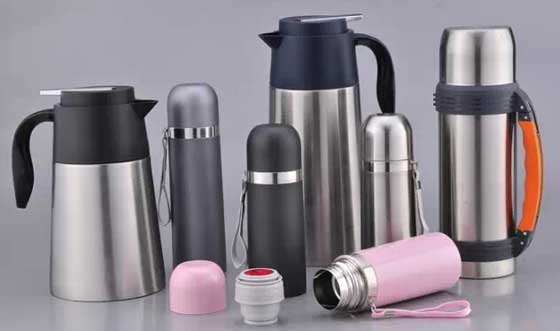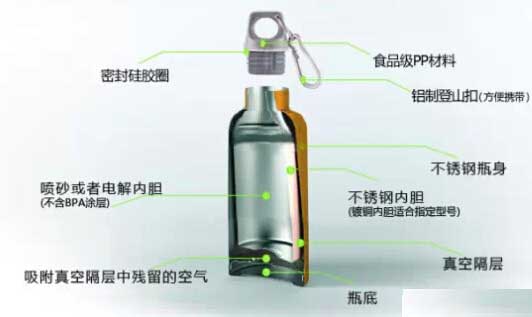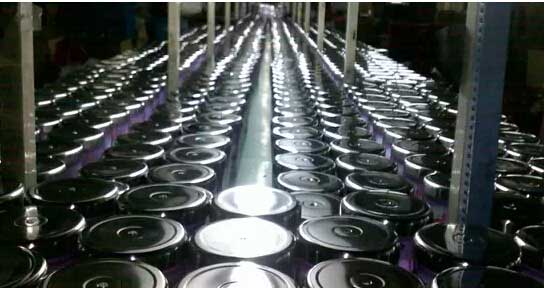The stainless steel insulation cup is made of inner and outer double-layer stainless steel. The inner tank and shell are combined by welding technology, and the air in the interlayer between the inner tank and shell is pumped out by vacuum technology to achieve the effect of vacuum insulation.

Production process flow of stainless steel vacuum thermos cup
Stainless steel thermos cup
The stainless steel heat preservation cup is characterized by a cover on the top and tight sealing. The vacuum insulation layer can delay the heat dissipation of water and other liquids installed inside, so as to achieve the purpose of heat preservation. The thermos cup is developed from the thermos bottle. The heat preservation principle is the same as that of the thermos bottle, but people make the bottle into a cup for convenience. There are three ways of heat transmission: radiation, convection and transmission. The silver cup liner in the thermos cup can reflect the radiation of hot water. The vacuum of the cup liner and the cup body can block the transfer of heat, while the bottle that is not easy to transfer heat can prevent heat convection.

Production process flow of stainless steel vacuum thermos cup
Production process flow of stainless steel thermos cup
1、 Shell processing flow
Outer pipe picking – pipe cutting – bulging – segmenting – bulging – rolling middle angle – bottom shrinking – bottom cutting – reinforcement – flat upper mouth – bottom flushing – flat bottom mouth – cleaning and drying – Inspection and pit knocking – qualified shell.
2、 Inner shell processing flow
Inner pipe picking – pipe cutting – flat pipe – bulging – rolling upper corner – flat upper mouth – flat bottom mouth – thread rolling – cleaning and drying – pit inspection – butt welding – water test and leak detection – drying – qualified inner tank.
3、 Shell and inner shell assembly process
Cup mouth – welded junction – pressing midsole – welding bottom – Inspection of welded junction welding bottom – spot welding getter for midsole – tailless vacuum technology vacuumization – temperature measurement – electrolysis – polishing – temperature measurement – Inspection and polishing – pressing Outsole – Painting – sampling temperature measurement – Inspection and painting – silk screen printing – Packaging – finished products warehousing.
Brief description of production process of stainless steel thermos cup
Production process flow of stainless steel vacuum thermos cup

- Pipe cutting: with a lathe. Accurate size is required; Find defective products and waste materials in time, and avoid pits, pits, pits and waste products during operation.
- Water expansion: water expansion press. It is required to pay attention and always pay attention to whether the pit, size and shape of the product meet the requirements.
- Section: cut off the two shells of water expansion one and two with an instrument car. The size shall be accurate, the cutting shall be uniform, without notch and burr.
- Bulging: use a large press, and the pipe weld of the shell shall correspond to the joint of the die. It is required to pay attention, that is, the pipe welding position of the shell shall correspond to the joint of the die, and always pay attention to whether the pit, size and shape of the product meet the requirements.
- Rolling middle angle: use a lathe to roll the two corners of the concave shape of the bulging shell to meet the size requirements.
- Shrink the bottom: use a lathe to shrink the circular arc bottom opening of the bulging shell to meet the dimensional requirements. Pits, pits, pits and waste products shall be avoided.
- Bottom cutting: use a lathe to cut the bottom opening of the shell that has shrunk over the bottom to the standard size. The cutting shall be uniform without notch and burr.
- Punching: flatten the welding joint at the shell opening on a small press, so that the welding will not skip during the welding, so as to make the welding joint smooth and uniform.
- Shell flat upper mouth: use a lathe to make the flat mouth uniform without notch and burr.
- Bottom punching: with a press, always pay attention to whether the pit, size and shape of the product meet the requirements and whether there are cracks at the bottom of the punching.
- Flat bottom opening: the instrument car shall be used, and the flat bottom opening shall be uniform without notch and burr.
- Flat pipe: use the instrument car to level one end of the pipe orifice, and the flat orifice shall be uniform without notch and burr.
- Roll the upper corner: roll the bulged corner of the inner tank to meet the dimensional requirements with a lathe.
- Flat upper opening of inner tank: use instrument car, and the flat opening is uniform without notch and burr.
- Thread rolling: use a special thread machine to adjust the thread depth to meet the size requirements.
- Cleaning and drying: clean the inner tank and shell and dry them.
- Inspection and pit knocking: inspect whether the inner tank and shell are qualified, and knock those with pits and pits to meet the requirements.
- Butt welding: butt weld the inner tank with the inner bottom. The welding seam shall be smooth, free of holes and pits.
- Water test and leak detection: inflate the butt welded inner tank to test whether there is any leak in the weld, and it is qualified if there is no leakage.
- Cup mouth: put the inner tank and shell together, and the cup mouth is flat.
- Bottom of welded junction: ensure that the bottom of welded junction is fully welded and smooth without concave convex points, weld beading and missing welding points.
- Spot welding: spot weld the getter on the midsole. The getter on the spot welding must be vacuumized within 24 hours, otherwise it will be invalid.
- Press the midsole: press the cup with welded mouth on the midsole with spot welding getter, and press it flat with the bottom mouth.
- Inspection of welded junction and weld bottom: inspect the cup with welded junction bottom, and pick out the cup with missing welding, poor cup junction welding or other bad reasons.
- Vacuum pumping: tailless vacuum technology shall be implemented in strict accordance with the vacuum pumping standard.
- Temperature measurement: check whether the cup is vacuum and pick out the non vacuum cup.
- Electrolysis: send it to outsourcing electrolysis. The electrolysis in the cup is required to be bright and uniform without watermark and yellow dot.
- Polishing: the cup shell shall be polished finely and orderly, and the cup mouth shall be smooth and bright.
- Inspection and polishing: check whether the polished cup meets the requirements, and pick out the bad ones and throw them again.
- Press the outsole: press the outsole on the polished cup, which is required to be flattened.
- Painting: send it to the outsourcing for painting. The color is the same. The painting shall be uniform and firm without paint falling, pitting, etc.
- Inspection of painting: check whether the painted cup meets the painting requirements. If it is not good, it is required to withdraw the paint and polish again. If it is good, the next process will be finished.
- Silk screen printing: the trademark logo shall be clearly printed according to the requirements. The pattern, size, color and position are the same. The silk screen logo can not be stuck with plastic bags and it is difficult to buckle with nails. Therefore, it must be baked with a drying channel after silk screen printing.
- Packaging.